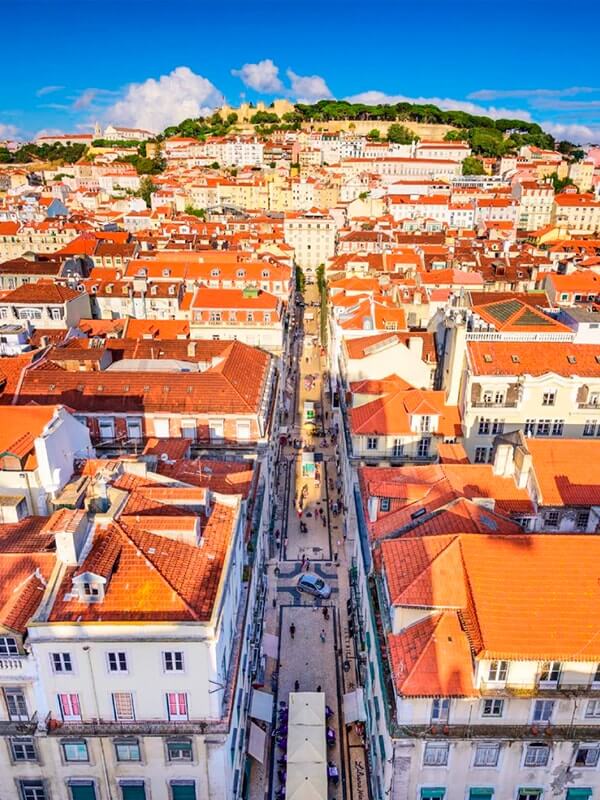
Olhão of the brave fishermen

From the “bioco”, the hooded black hood formerly worn by women, to the architecture, Olhão has a unique identity, born of a spirit of defiance of authority.
“I get out in the morning in Olhão and I’m dazzled”, Raul Brandão writes in his book The Fishermen, about the then still village, which he visited in August of 1922. “Cobalt-blue sky—underneath, lime-plated. The reverberation of the sun, and the bluest blue, the whitest white. Cubes, geometric lines, animal light that trembles and vibrates like the wings of a cicada. […]It is a Levantine land that I discover; only lacking the slender minarets.”
Olhão has character and this, those who know it well say, comes from a history made, since the beginning, of a spirit of independence and challenge. It was born almost by chance, by the hand of fishermen coming from Faro (later joined by others from Ovar and Ílhavo) who moved here, especially in the months of March, April and May, for fishing.
Realizing the richness of the waters of the Formosa estuary waters, the fishermen began settling more definitively, in the beginning in huts made with wood and straw. There is an article on the site www.olhao.web.pt that since the beginning of the seventeenth century there was registration of residents on the beach of Olhão, but only in 1715 was given permission for the construction of the first house in masonry - so far, the text refers, "The political power in Faro" had always refused these constructions.
Hence comes the spirit of challenge of this land of fishermen that, even without the recognition of the Civil Government of Faro, would eventually assert itself. Which happened at the time of the French invasions. "Probably because of their egalitarian spirit, without commitment to any established powers, the citizens of Olhão led the first successful uprising against the French occupation in the nineteen century," the text continues.
Proud of the feat, a dozen or so sailors decided to take to the sea on the Bom Sucesso kayak (today a replica of this boat can be seen in the estuary, in front of the Market) to sail to Brazil and give the news to King D. João VI. The King, impressed by the courage of the men who had crossed the Atlantic in a small boat, raised Olhão from hamlet to village, from hence to be called Vila de Olhão da Restauração.
But the gestures of defiance would continue to repeat themselves over time. See the persistence in Olhão of the female costume here called a “bioco”, a hooded black cape, almost entirely covering the woman, which was used in other parts of Algarve until it was prohibited, in 1892, by the Civil Governor of Faro, an order that, of course, the women of Olhão ignored, continuing to wear it until the beginning of the 20th that made them so similar to the Algerians and Moroccans women on the other side of the sea - "impenetrable", in the words of Raul Brandão.
While conquering their autonomy, the people of Olhão also explored other stops. The links to Northern Africa (and to the South of Angola) were always very strong and Raul Brandão remembers how, half a century before its visit, “Olhão, ingrained in brine and lost in the world, lived only of the sea.”
The writer explains that “Olhão’s great business was always smuggling”, which also reveals the character of people, because “not everyone can be a smuggler: you need intelligence and cunning, boldness, the watchfulness of a wild chief and a poet’s imagination.” In any case, "everyone in Olhão, rich and poor, protected the smugglers and went into business", and therefore "never a piece of a farm was seized on land." When they were suspicious, they passed from hand to hand, disappearing from rooftop to rooftop, "for which it is enough to extend the arm."
It was this scenario of houses built like cubes, with rooftops always rising higher, that, in the 1940s, enchanted photographer Artur Pastor, author of possibly the most beautiful photos of the narrow streets of the neighborhood of Barreta and the clipping of Olhão against the sky.
Some of the images of Artur Pastor can be seen in the City’s Museum, in the building of the Maritime Commitment, in front of the Church of Our Lady of Soledad, the first stone building in the city and on whose facade was placed an illuminating stone: At the expense of the men at sea of this people this new temple is made at a time when there were only a few huts in which they lived. "
This sea of rooftops not only served to conceal contraband - the terraces were used, above all, to dry figs or carob. In a 1945 text, Francisco Fernandes Lopes explains why, in this aspect, Olhão is different from other algarvian lands (note, for example, that the chimneys are smooth, straight lined, and not laced): and the fact that from one rooftop you can climb to another, and finally to the lookout, which in some cases may still have a smaller viewpoint. They are "three terraces overlapping in pyramid", a "specificity", writes the author, "unique throughout the Algarve, throughout Portugal, all over the world itself."
For Raul Brandão, the roof is nothing less than the best part of the house: "The man from Olhão has an ingrained passion for it. If a neighbour raises it, he is never left behind – and raises it up higher. Because the roof is his delight: a splendid place to breathe, a threshing floor for the carob and the fig, and a room to sleep in the summer under a piece of candle.
